Infocom was an American software company based in Cambridge, Massachusetts, that produced numerous works of interactive fiction. They also produced a business application, a relational database called Cornerstone.

Suspended: A Cryogenic Nightmare is an interactive fiction video game written by Michael Berlyn and published by Infocom in 1983. Infocom's sixth game, it was released for Amstrad CPC, Apple II, Atari 8-bit computers, Commodore 64, Commodore Plus/4, IBM PC compatibles, TRS-80, and TI-99/4A. It was later available for Mac, Amiga, and Atari ST.

Leather Goddesses of Phobos is an interactive fiction video game written by Steve Meretzky and published by Infocom in 1986. It was released for the Amiga, Amstrad CPC, Amstrad PCW, Apple II, Mac, Atari 8-bit computers, Atari ST, Commodore 64, TI-99/4A, and MS-DOS. The game was Infocom's first "sex farce", including selectable gender and "naughtiness"—the latter ranging from "tame" to "lewd". It was one of five top-selling Infocom titles to be re-released in Solid Gold versions. It was Infocom's twenty-first game.

Cinemaware was a video game developer and publisher. It had released several titles in the 1980s based on various film themes. The company was resurrected in 2000, before being acquired by eGames in 2005.

Uninvited is a black-and-white horror-themed point-and-click adventure game. It was originally developed for the Macintosh by ICOM Simulations and released in 1986 by Mindscape as part of the MacVenture series.
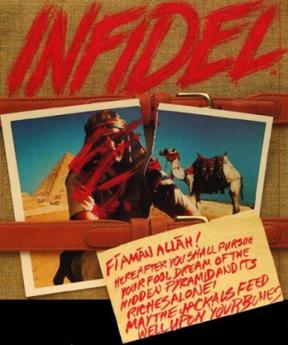
Infidel is an interactive fiction video game published by Infocom in 1983. It was written and designed by Michael Berlyn and Patricia Fogleman, and was the first in the "Tales of Adventure" line. It was released for the Amstrad CPC, Apple II, Atari 8-bit computers, Commodore 64, IBM PC compatibles, TRS-80, and TI-99/4A. Ports were later published for Mac, Atari ST, and Amiga. Infidel is Infocom's tenth game.

Moonmist is an interactive fiction game written by Stu Galley and Jim Lawrence and published by Infocom in 1986. The game was released simultaneously for the Amiga, Amstrad CPC, Apple II, Atari 8-bit computers, Atari ST, Commodore 64, MS-DOS, TRS-80, TI-99/4A, and Mac. It is Infocom's twenty-second game. Moonmist was re-released in Infocom's 1995 compilation The Mystery Collection, as well as the 1996 compilation Classic Text Adventure Masterpieces.
Transylvania was the name of a trilogy of computer games released for several home computers of the 1980s. The games were graphic adventure games created by Antonio Antiochia and produced by Penguin Software/Polarware.

Wizardry: Proving Grounds of the Mad Overlord is the first game in the Wizardry series of role-playing video games. It was developed by Andrew C. Greenberg and Robert Woodhead. In 1980, Norman Sirotek formed Sir-Tech Software and launched a beta version of the product at the 1980 Boston Computer Convention. The final version of the game was released in 1981.

Portal is a text-driven adventure with a graphical interface published for the Amiga in 1986 by Activision. The writing is by American author Rob Swigart, and it was produced by Brad Fregger. Ports to the Commodore 64, Apple II, and IBM PC were later released. A version for the Atari ST was announced and developed, but not published. Until recently, it was thought that a Mac version left unpublished. The published Mac version was rediscovered in 2021 by a game collector.
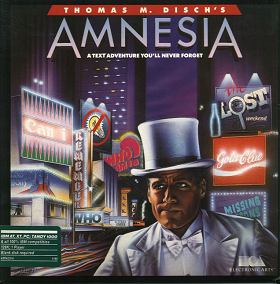
Amnesia is a text adventure written by science fiction author Thomas M. Disch and programmed by Kevin Bentley. It was published by Electronic Arts in 1986 for IBM PC compatibles and Apple II. A Commodore 64 version was released in 1987. Disch's ironic, rich writing style is in distinct contrast to the functional or tongue-in-cheek tone of most text adventures. Over half of Disch's novel-length manuscript had to be cut from the published version to fit on a 5¼" floppy disk.

Rebecca Ann Heineman is an American video game designer and programmer. Heineman was a founding member of video game companies Interplay Productions, Logicware, Contraband Entertainment, and Olde Sküül. She has been chief executive officer for Olde Sküül since 2013.

Michael Berlyn was an American video game designer and writer. He was best known as an implementer at Infocom, part of the text adventure game design team. He is also known as the designer behind Bubsy in Claws Encounters of the Furred Kind (1993) and Bubsy 3D (1996).
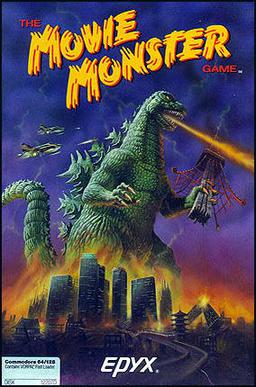
The Movie Monster Game is a computer game released by Epyx for the Apple II and Commodore 64 in 1986. The game offers a variety of scenarios, playable monsters, and cities to demolish. The monsters are based on popular movie monsters such as The Blob, Mothra, the Stay Puft Marshmallow Man, and the Transformers, and Epyx was able to officially license Godzilla.
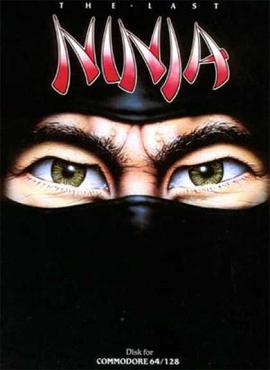
The Last Ninja is an action-adventure game developed and published by System 3 in 1987 for the Commodore 64. It was converted to the Apple IIGS, MS-DOS, BBC Micro and Acorn Electron in 1988, the Apple II in 1989, the Amiga and Atari ST in 1990, and the Acorn Archimedes in 1991.

World Games is a sports video game developed by Epyx for the Commodore 64 in 1986. Versions for the Apple IIGS, Amstrad CPC, ZX Spectrum, Master System and other contemporary systems were also released. The NES version was released by Milton Bradley, and ported by Software Creations on behalf of producer Rare. The Master System version was done by Sega.

Space Quest: Chapter I – The Sarien Encounter is a graphic adventure game, created by Scott Murphy and Mark Crowe, and released in October 1986 by Sierra On-Line. It is the first game in the Space Quest series, and sees players assume the role of a lowly janitor on a research ship, who becomes involved in stopping an alien race using a new form of technology for evil purposes.
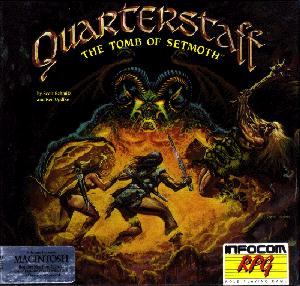
Quarterstaff: The Tomb of Setmoth is an interactive fiction role-playing video game developed by Scott Schmitz and Ken Updike and released by Infocom for Macintosh in 1988. The game features a text parser, graphics, a dynamically updated map, and a graphical interface that incorporates Mac OS hierarchical menus.

GBA Championship Basketball: Two-on-Two is a sports video game for IBM PC compatibles Amiga, Apple II, Apple IIGS, Amstrad CPC, Atari ST, ZX Spectrum, and Commodore 64. It was developed by Dynamix and published in 1986 by Activision.

Shanghai is a computerized version of mahjong solitaire published by Activision in 1986 for the Amiga, Atari ST, Atari 8-bit computers, Commodore 64, MS-DOS, classic Mac OS, Apple IIGS, and Master System. Shanghai was originally programmed by Brodie Lockard. It was released as an arcade video game by Sunsoft in 1988.



















